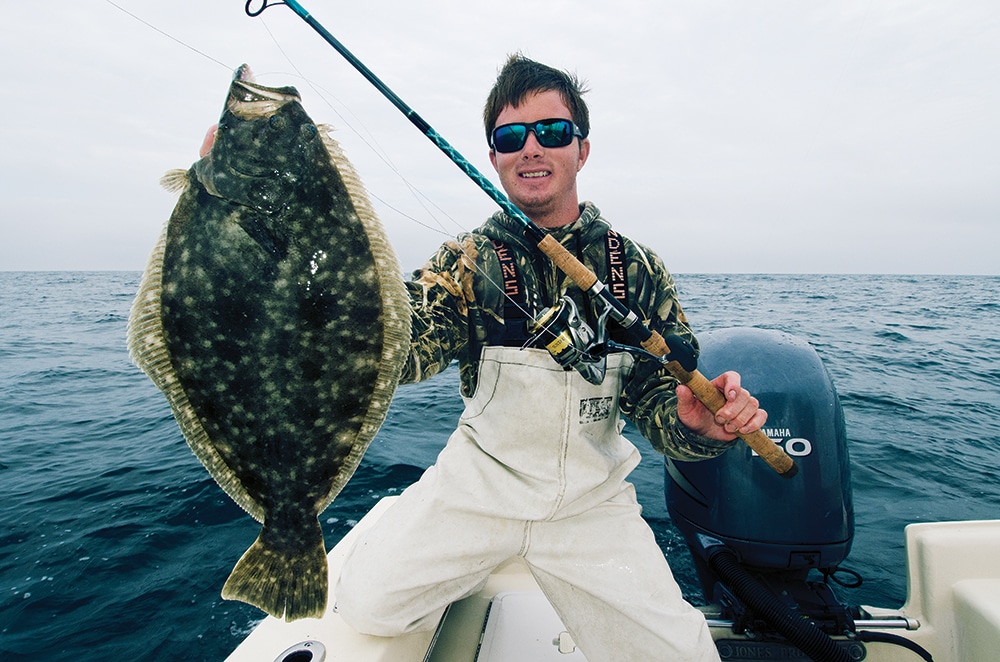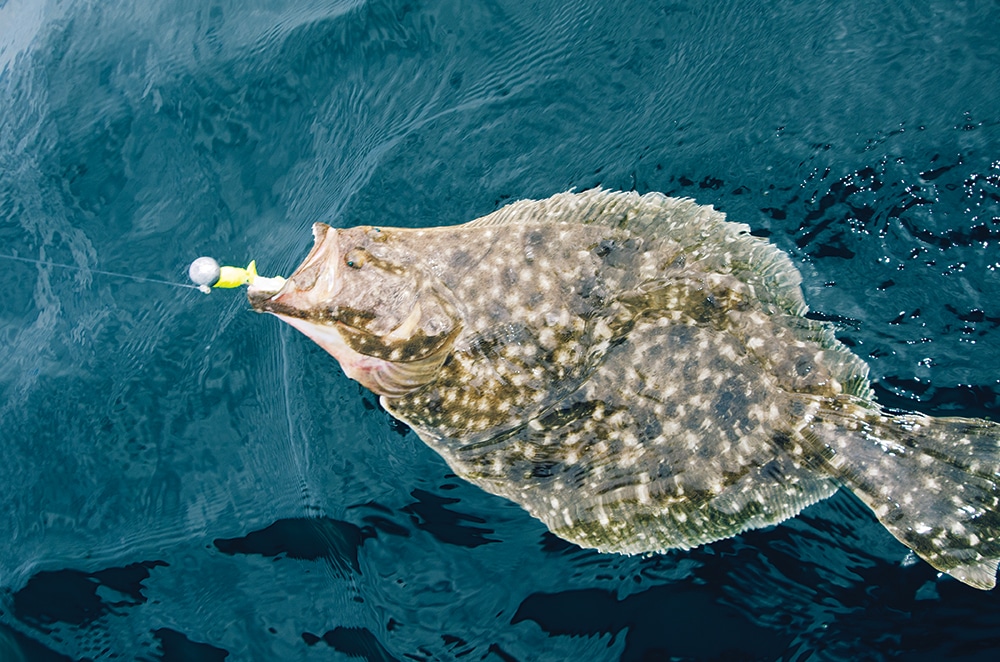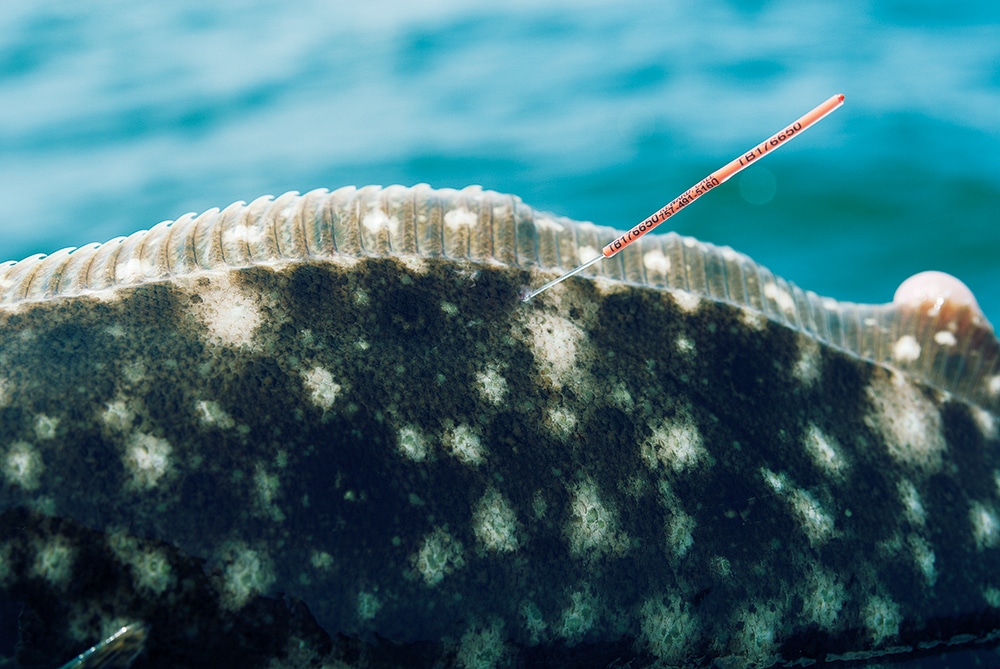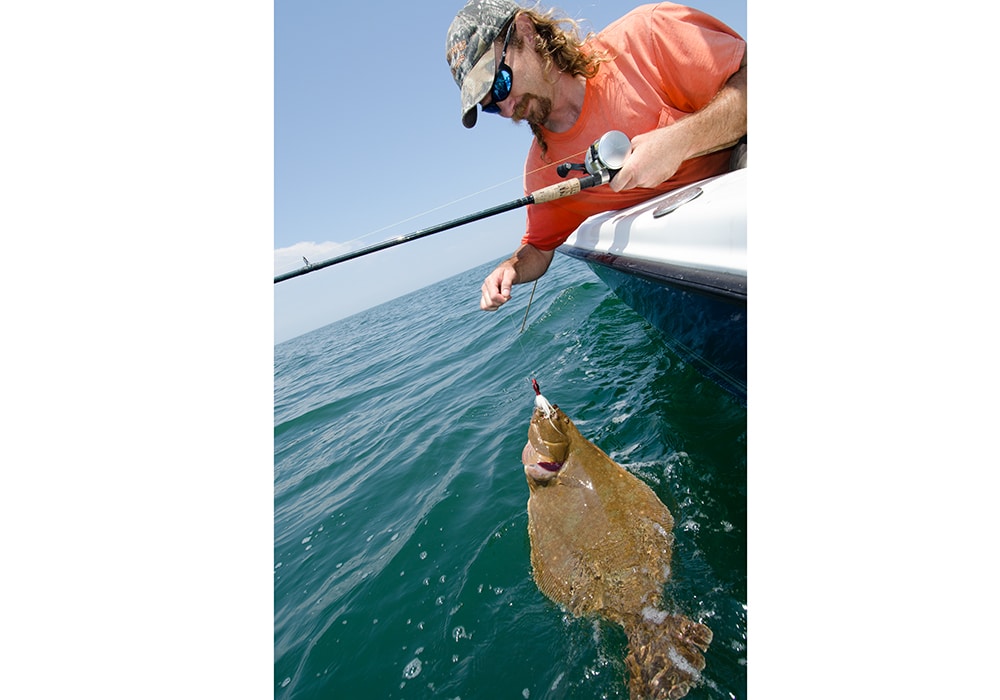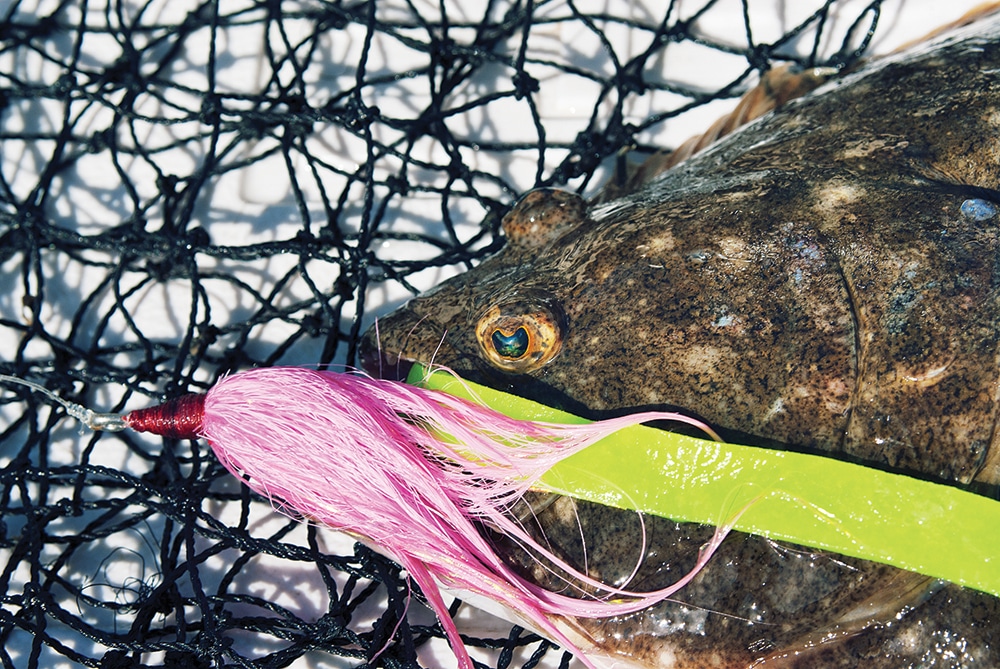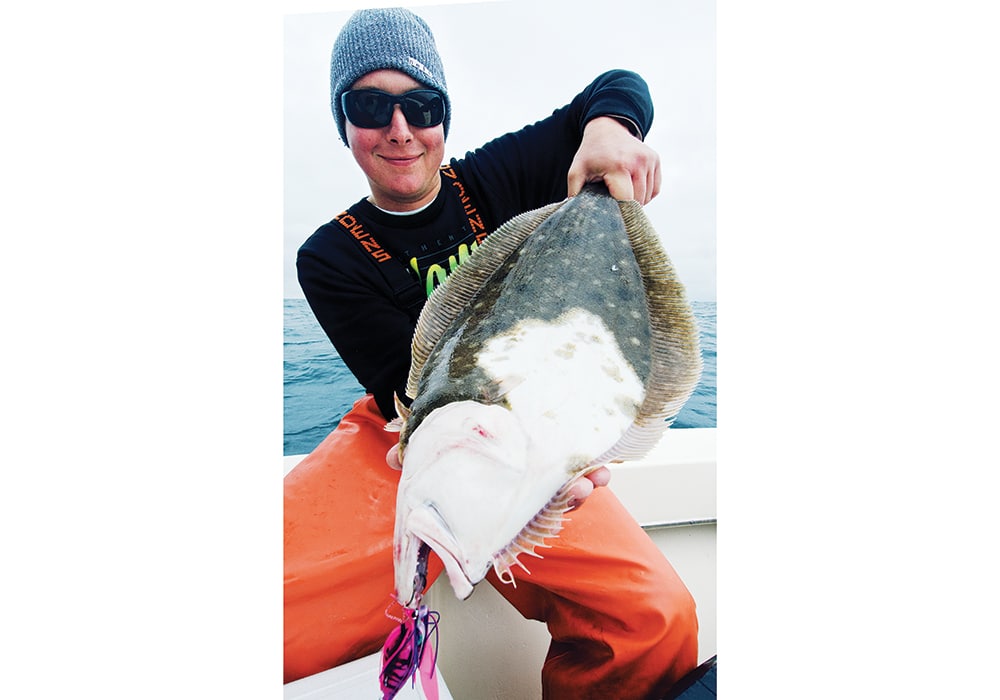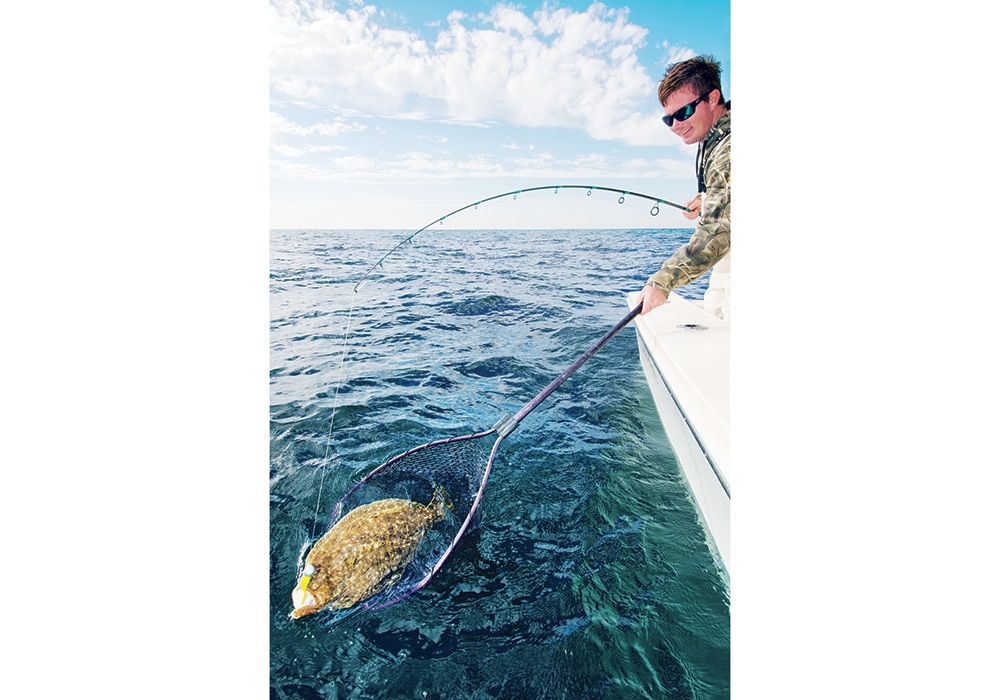I hit “post” on my Facebook status and waited for the storm of comments. “Damn” was the first. “Meat” was the second, followed by “Awesome Catch!” and “Wow.” Likes poured in. About a half-dozen friends shared the post. Each time my smartphone pinged, I chuckled. In just a few minutes, my picture of Capt. Hunter Tucker surrounded by a limit of doormat flounder went viral. “Where’s that?” one friend asked. Tucker quickly responded: “We could tell you, but then we’d have to use you for shark bait!”
Last year was tough for mid-Atlantic flounder fishermen. Anglers drifting traditional three-way flounder rigs in well-known flounder holes were frustrated with scattered catches of small fish. So when I posted my picture of 16 fat flounder scattered on the deck of Tucker’s Hawg Hunter, a 24-foot Triton center-console, reactions ranged from congratulations to downright jealousy.
In recent years, anglers fishing Chesapeake Bay and the mid-Atlantic have taken a different approach to flounder fishing. With summer flounder stocks down and bag limits tight, flounder-pounders must look for keeper flatties in new places with new techniques.
Go Deep
Now that almost a year has passed, I can finally divulge the secret to our catch without worrying about Tucker’s shark-bait threat. On a late-June day, while the rest of the flounder-fishing world was drifting in the lower Chesapeake, Hunter, two of his buddies and I were working a field of artificial reefs 14 miles off Virginia Beach.
Summer flounder actually spend a good portion of their life in the ocean. Each fall the fish leave estuaries and head as far as 50 miles offshore to spawn. Then, through winter and into spring, the baby flounder travel ocean currents back inshore to the shallow marshes and skinny backwaters, where they spend their first two years before returning offshore and repeating the cycle.
While most flounder return to inshore estuaries in spring, many fish stay at nearshore wrecks and reefs through summer. Submerged structures as close as a mile off the beach can hold impressive numbers of flatties. Along the Virginia Beach Oceanfront, there are storm-water pumping stations at 14th, 42nd and 80th streets that draw flounder to the beach. To find these hidden hot spots, slowly motor 500 yards off the beach and search the fish finder for solid structure.
Farther up the beach, the Cape Henry and Anglo African wrecks in the mouth of Chesapeake Bay also hold good numbers of flounder in the summer. Strong currents scour these two wrecks, so the best time to fish is around the change of the tide.
Moving farther offshore, wrecks in 40 to 60 feet of water such as the Santori, Tiger, and the artificial reefs around Chesapeake Light Tower are also an excellent starting point through summer and into fall.
As the days get shorter and the temperatures drop, the full onslaught of the flounder migration hits wrecks 20 to 30 miles from the beach. The Gulf Hustler, Hanks and the scuttled surplus ships at the Triangle reef explode with flounder from late October through December.
While the fish scatter for the coldest months of the winter, by April the big flatties have moved back into Chesapeake Bay. When the drift bite is slow, look for the flounder tight to structure such as the pilings and rocks of Chesapeake Bay Bridge-Tunnel, and artificial reefs like Back River Reef, ODU Reef and Bluefish Rock. The ocean bite fires up again in May with big flatties moving into Rudee Inlet on the Virginia Beach resort strip and returning to nearshore wrecks.
Go Light
Finding fish on the wrecks and reefs is only half the battle; an angler has to get his bait deep into the structure before declaring victory. Picture a flounder lying on the bottom of the sea. The fish is half-covered with sand, hiding next to the wreck, waiting for a hapless baitfish to make a careless mistake. To fool this flounder, it takes precision fishing with light tackle.
Two advancements in technology have made deepwater, light-tackle flounder fishing productive: scented soft plastics and braided line.
The typical way to catch flounder is by drifting a three‑way rig and strip bait across open bottom. To make a classic flounder rig, start by tying a 2-foot piece of 50-pound monofilament leader and 4- to 8-ounce bank sinker to one eye of a three-way swivel. On the second eye, add a 6-foot trailer of 50-pound mono. Slide a bucktail skirt, beads and spinners over the longer leader, and tie on a 5/0 Kahle hook. Bait the hook with a strip of squid, and tip it with a live gudgeon minnow (killifish). This rig works great over open bottom and can be effective when drifting around the wrecks, but the two leaders, sinker and trailer hook can easily get snagged in gnarly structure where flounder live.
To target fish deep in the structure, top flounder fishermen use small jigs and bucktails tipped with a scented soft-plastic tail.
The rig starts with a ½- to 3-ounce ball-head jig or butter-bean bucktail. These models are more streamlined and sink faster than other types of jigs. The key is to choose the smallest jig that will stay on the bottom.
The jig is paired with a 4- to 6-inch curly-tail soft plastic. Add scent to the package via a scented soft plastic, a strip of cut squid or a spray-on scent. Again, remember that the smaller the bait, the better. Choose a bucktail with less hair, or trim down the curly-tail jig so the lure falls through the water with the least resistance.
Tie the jig to 6 feet of 50-pound fluorocarbon with a uni-knot. Not only is the fluorocarbon virtually invisible underwater, it’s also stiffer and tougher than monofilament, making it more resistant to abrasion from the wreck.
Attach the fluorocarbon leader to the 20-pound-test braided main line. Braided line is super sensitive and super thin. Twenty-pound braided line has the same diameter as 8-pound-test monofilament, so the braid will cut through the water and allow the angler to use a lighter lure in heavy current and deep water. Not only that, but braided line is more sensitive than monofilament, so the angler will feel every bite of a sneaky flounder.
Flounder anglers argue over the best choice of rod and reel. I prefer a 7-foot, medium-action casting setup because I can disengage the spool quickly to pay out line as I drift over the wreck. Some anglers prefer a spinning reel, which releases line off the spool without any resistance. This enables the lightest lure to reach the bottom. Either way, a supersensitive, high-modulus graphite or composite rod is mandatory. These space-age materials make it possible to detect the superlight tap of a feeding flounder. To further increase sensitivity, look for a rod that has an exposed blank in the reel seat and rod butt. This will telegraph the lightest bite and softest bounce 150 feet up and directly to the angler’s fingers.
Not only does improved sensitivity help detect the lightest bump of a chewing flounder, but it also allows the angler to feel the wreck and avoid a snag. When it comes to light-tackle flounder fishing in deep water, if you’re not occasionally getting snagged, then you’re probably not going to get bit.
Get Tight
Scuba divers who visit these wrecks and reefs often report flounder lying directly on the structure or right next to it. Bouncing bait over the reef and landing it where the solid stuff meets the sand is key to fooling these fish.
That takes some fancy boat handling and careful rod work. When I first arrive to the wreck and mark it on my bottom machine, I take the engine out of gear and make a test drift to see what direction the current and wind will move the boat.
Then I follow my track back to the wreck and continue to motor just past the structure. Before I start fishing, I turn the boat 180 degrees and bump the engine in reverse to stop the boat. Then I tell the crew to drop their lures.
As we bounce our jigs over the wreck, I continue to bump the boat in reverse to slow our drift. If the lines are straight up and down, I let the boat drift. But as soon as I feel my own jig lose contact with the bottom, I put the engine in reverse until I feel the jig bouncing on the structure again.
To keep my jig out of snags, I let it touch bottom only for a second before lifting the rod tip as high as possible and letting it fall again. Not only does this keep the jig from catching the wreck, but lifting the bait high in the water puts it in front of more fish that are lying on the bottom.
Hooking a flounder in deep water with light tackle is a challenge too. At the first tap of an interested fish, I drop the rod tip and wait for the next bite. The flounder will nibble its way up the jig tail toward the hook. Don’t set the hook hard. Instead, lift the rod tip solidly and start cranking steadily. Don’t pump the rod, don’t jerk the tip, and don’t reel fast. Just crank steadily with the rod tip pointing toward the water. Chances are the fish is still eating; any quick movement will pull the lure from the fish’s mouth. I’ve landed flounder that weren’t even hooked, and had many flounder continue to eat the jig even after the fish was lying on the deck.
It takes a light hand and patient retrieve to fool deepwater doormats. But that only makes flounder fishing more challenging — and more rewarding. With tight regulations, flounder anglers have turned from meat fishermen to finesse anglers. Using light tackle and fishing deep water makes flounder fishing more about fun than drifting all day and filling the cooler with fillets. Give the technique a try this summer, and you’ll be the envy of your Facebook friends.
Virginia Flattie Holes
Hit these hot spots for deepwater, light‑tackle flounder fishing:
Cape Henry: N 36 57’36.1″//W 076 00’38.3″
Anglo African: N 37 03’25.2″//W075 53’56.6″
Santori: N 36 53’53.6″//W075 46’50.7″
Tiger: N 36 45’57.2″//W075 46’17.9″
Gulf Hustler: N 36 51’40.0″//W075 36’18.6″
Hanks: N 36 43’42.6″//W 075 34’09.2″
For maps showing artificial-reef locations, type “artificial reefs” into your browser’s search engine, followed by the state. Seasons, minimum size and bag limits for flounder are subject to change at almost any time. For the most up-to-date information, check each state’s fisheries website.
Virginia Flounder Pros
Capt. Hunter Tucker, Hawg Hunter Charters, 804-731-3552
Capt. Brandon Bartlett, On Point Sportfishing, 757-969-3495
Capt. Craig Paige, Paige II Charters, 757‑672‑9381
